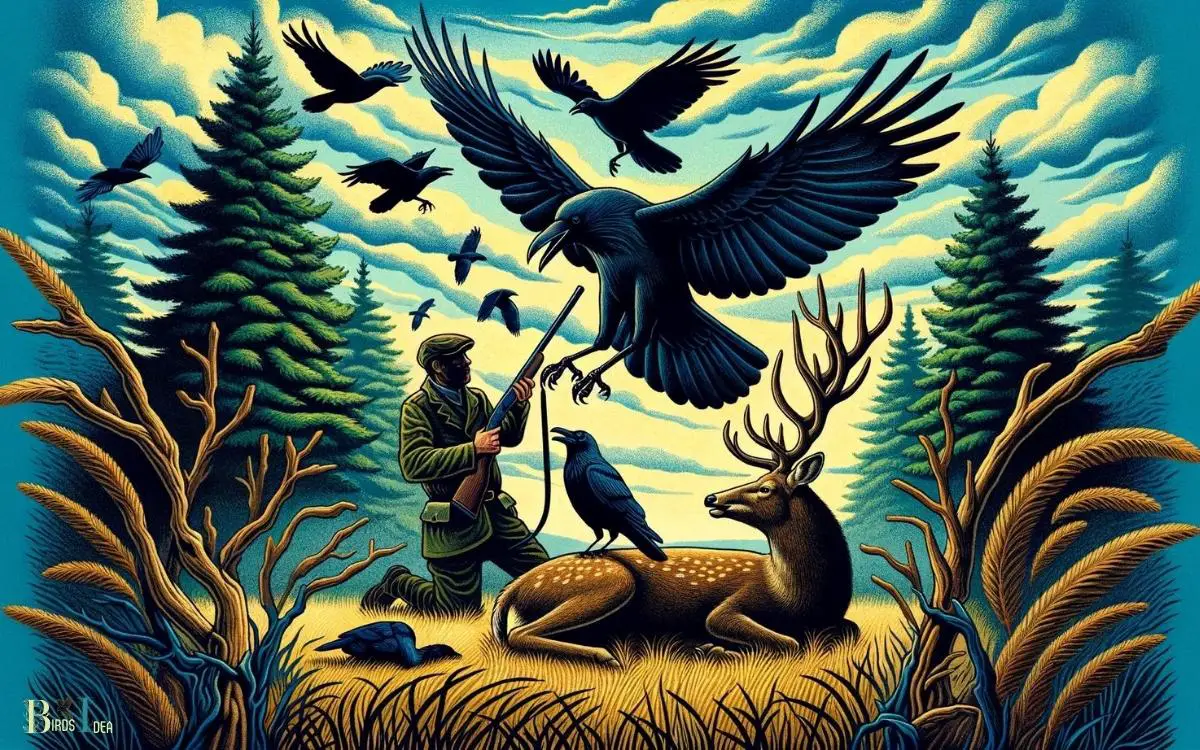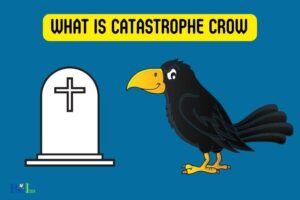What Do Crows Mean When Deer Hunting? Discover!
Crows can be an important indicator for deer hunters, as their presence and vocalizations may signal deer activity nearby.
Hunters who understand crow behavior can use it to their advantage to track and locate deer more effectively.
Crows are intelligent birds that often react to disturbances in their environment, including the movement of deer.
Here are key points to understand:
- Alert System: Crows may loudly caw when they spot a predator or a large animal like a deer, potentially alerting hunters to deer in the vicinity.
- Observation: Hunters can watch crows to see if they are following or harassing a deer, which can lead to discovering the animal’s location.
- Movement Influence: Crows can affect deer movement by causing them to change their path to avoid the noisy birds.
Integrating knowledge of crow behavior into deer hunting strategies can enhance a hunter’s ability to predict and locate deer, turning the crows into unwitting allies in the field.

Key Takeaway
The Role of Crows in Deer Behavior
Studying the influence of crows on deer behavior provides valuable insights into the dynamics of predator-prey interactions in the wild.
Crows are known to scavenge carcasses left by predators, and their presence can alert deer to potential danger.
Research has shown that deer are highly attuned to the alarm calls of crows, responding with heightened vigilance and evasive behaviors.
Furthermore, crows are opportunistic predators themselves, preying on fawns and injured deer. Their presence can therefore have a direct impact on deer population dynamics. Understanding how crows influence deer behavior is crucial for wildlife management and conservation efforts.
Understanding Crow Calls and Signals
Understanding crow calls and signals is crucial for hunters seeking to interpret the behavior of nearby deer.
Crow alerts can indicate the presence of deer, while the specific type of crow calls can guide hunters to the deer’s location.
Furthermore, using crow calls to attract deer has been a traditional hunting strategy, making it essential for hunters to grasp the meanings behind various crow signals.
Crow Alerts Deer
The phenomenon of crow alerts during deer hunting requires keen observation and interpretation of the birds’ vocalizations and behavior.
Crows are known to emit different calls and signals when they spot a predator, such as a human hunter, in the vicinity.
These warning signals alert deer to the potential danger, causing them to become more vigilant and cautious.
Understanding the specific vocalizations and behaviors of crows can provide valuable insights into the presence and movements of deer in the area.
By paying close attention to the cues provided by the crows, hunters can adapt their strategies accordingly, increasing their chances of a successful hunt.
The next section will delve into the concept of ‘crow guides deer’, exploring the intricate relationship between these two species during the hunting process.
Crow Guides Deer
During deer hunting, crows communicate valuable information to deer through specific calls and signals.
Crows are known to guide deer to food sources, water, and potential dangers by using distinct vocalizations and body movements.
Understanding these crow calls and signals can provide hunters with valuable insights into the whereabouts and behavior of deer.
Below is a table illustrating some common crow calls and their meanings:
| Crow Call | Meaning |
|---|---|
| Caw | Signaling the presence of food or water |
| Rhythmic Caw | Alerting deer to potential danger or predators |
| Short, Sharp Caw | Indicating the location of a potential food source |
By decoding these signals, hunters can gain a deeper understanding of deer movements and behavior. This knowledge empowers them to make informed decisions during their hunting expeditions.
Understanding how crows guide deer is crucial, but equally important is knowing how crows attract deer, which will be discussed in the following section.
Crow Attracts Deer
Crow calls and signals play a crucial role in attracting deer during hunting expeditions. Understanding the significance of crow communication can greatly enhance a hunter’s success.
Here are three key points to consider:
- Mimicking Crow Calls: By imitating the sounds of crows, hunters can create a sense of security for deer, as crows are known to signal the absence of predators in the area. This can attract deer towards the perceived safety of the location.
- Crow Distress Calls: Utilizing crow distress calls can pique the curiosity of deer, as they are naturally drawn to investigate potential sources of danger or distress. This can lead them closer to the hunter’s position.
- Crow Movement: Observing the movement of crows can provide valuable insights into the presence of deer. Crows often gather near feeding areas, and their behavior can indicate the proximity of deer.
Crow Behavior and Deer Movement
An observable increase in crow activity has been associated with a corresponding movement of deer in the vicinity.
Crows are known to be highly intelligent and have keen observational skills. When crows are actively engaged in hunting or foraging for food, they often alert other animals to potential dangers, including the presence of predators.
Deer, being naturally vigilant animals, tend to pay attention to the alarm calls and behaviors of crows. As a result, they may become more cautious and alert, leading to a shift in their movement patterns.
Understanding the relationship between crow behavior and deer movement can provide valuable insight for hunters seeking to locate deer in the wild.
Now, let’s delve into how hunters can use crow patterns to effectively locate deer in their hunting expeditions.
Using Crow Patterns to Locate Deer
Leveraging the observable increase in crow activity can be a strategic method for hunters to pinpoint the location of deer during expeditions.
When using crow patterns to locate deer, hunters should consider the following:
- Scouting: Pay attention to the direction and intensity of crow calls and movements, as they can indicate the presence of deer in the area.
- Timing: Take note of the time of day when crows are most active, as this can signal when deer are likely to be on the move.
- Adaptation: Be flexible and adaptable in response to changes in crow behavior, as this can provide valuable insights into the movements of deer in different weather conditions or times of the year.
Understanding and interpreting crow patterns can significantly enhance a hunter’s ability to locate deer during hunting expeditions.
This knowledge can also be used to anticipate the subsequent section about ‘crows as distraction for deer hunting’.
Crows as Distraction for Deer Hunting
Crows can play a significant role in deer hunting by serving as distractions. Their presence can scatter deer, making it more difficult for hunters to track and target them.
The signals crows give off can alert deer to potential danger, causing them to change their behavior and movements.
Lastly, the disruptive nature of crows can create chaos in the hunting environment, making it challenging for hunters to maintain focus and precision.
Crows Scatter Deer
During deer hunting, the presence of crows can act as a significant distraction, scattering the deer and making it more challenging to track and hunt them.
- Crows have a loud and distinctive caw that can startle and alert deer to potential danger.
- Their sudden movements and aerial acrobatics can cause deer to become wary and flee the area.
- Crows are known to gather around potential food sources, and their presence may lead deer to avoid areas where they congregate.
Understanding the impact of crows on deer behavior is crucial for hunters, who may need to adapt their strategies to account for these intelligent and observant birds.
This knowledge provides hunters with the freedom to develop alternative methods and techniques to outsmart both the crows and the deer, ultimately leading to a successful hunt.
Crows Signal Deer
The presence of crows serves as a significant distraction for deer during hunting, requiring hunters to adapt their strategies to account for the impact of these intelligent and observant birds.
Crows have the ability to signal danger to other animals, including deer, through their vocalizations and behavior.
This can lead to deer becoming alert, cautious, and even fleeing the area, making it more challenging for hunters to approach or track them.
The table below summarizes the ways in which crows serve as a distraction for deer during hunting:
| Crow Behavior | Impact on Deer |
|---|---|
| Cawing loudly | Alerts deer to potential danger |
| Flying overhead | Causes deer to become vigilant and wary |
| Mobbing predators | Signals to deer that there is a threat nearby |
| Stealing food | Distracts deer and disrupts their feeding patterns |
Understanding how crows signal deer can help hunters anticipate and counteract these effects to improve their success in deer hunting. In the subsequent section, we will delve into how crows disrupt deer.
Crows Disrupt Deer
When hunting deer, crows can disrupt the prey by signaling danger and causing them to become vigilant and wary.
This disruption can significantly impact the success of the hunt, as the deer are more likely to flee or hide, making it harder for hunters to approach or take a shot.
The following factors contribute to crows’ disruptive effect on deer hunting:
- Crows’ loud calls and cawing can startle and alert deer to potential danger.
- The sight of crows circling or swooping in an area can make deer nervous and on edge.
- Crows may intentionally follow or harass deer, causing them to move away from hunting areas.
For hunters seeking freedom in their pursuits, understanding how crows disrupt deer can lead to better strategies for a successful hunt.
Interpreting Crow Activity for Hunting Success
Crow activity can serve as a reliable indicator of potential hunting success, offering valuable insights for hunters seeking strategic advantage.
When crows are actively calling and flying around, it often indicates the presence of a predator or a potential food source, such as a deer carcass or a wounded animal.
Observing the behavior of crows can help hunters identify areas where deer might be congregating, feeding, or bedded down.
Crows tend to mob around predators, so if hunters notice crows mobbing a certain area, it could signal the presence of a coyote, fox, or other predator that might drive deer toward the hunter’s location.
Conclusion
Crows play a significant role in deer hunting. They act as indicators of nearby deer, providing signals for understanding deer behavior, and even serving as distractions for hunters. By interpreting crow activity, hunters can increase their chances of hunting success.
Just as a skilled angler reads the ripples on the water to anticipate the movements of fish, so too can hunters interpret the behaviors of crows to anticipate the movements of deer in the wild.






